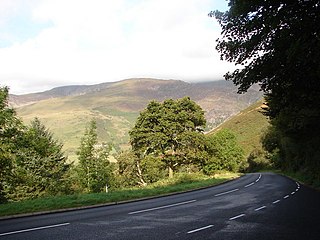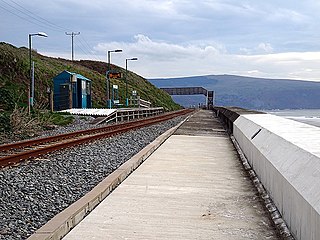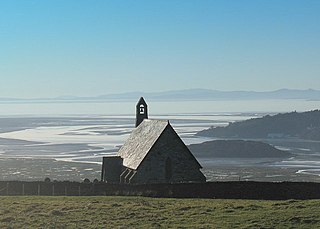
Snowdonia is a mountainous region in northwestern Wales and a national park of 823 square miles (2,130 km2) in area. It was the first to be designated of the three national parks in Wales, in 1951.

The A487, officially the Fishguard to Bangor Trunk Road, is a trunk road in Wales that follows the coast from Haverfordwest, Pembrokeshire, in the south, to Bangor, Gwynedd, in the north.

The Cambrian Line, also known as the Cambrian Main Line and Cambrian Coast Line, is a railway line that runs from Shrewsbury, England, westwards to Aberystwyth and Pwllheli in Wales. Passenger train services are operated by Transport for Wales Rail between the western terminals of Pwllheli, Gwynedd, and Aberystwyth, Ceredigion, with the eastern terminal at Shrewsbury, Shropshire as part of the Wales & Borders franchise. The railway line is regarded to be scenic, as it passes through the Cambrian Mountains in central Wales, Snowdonia National Park and along the coast of Cardigan Bay.

The River Dwyryd is a river in Gwynedd, Wales which flows principally westwards; draining to the sea into Tremadog Bay, south of Porthmadog.

Boston Lodge is situated at Penrhyn Isa, Minffordd, Penrhyndeudraeth, on the A487 road about 1 mile SE across the Afon Glaslyn causeway from Porthmadog, Gwynedd in north-west Wales.

Traeth Mawr is a polder near Porthmadog in Gwynedd in Wales. The area was formerly the large tidal estuary of the Afon Glaslyn. It was created after large-scale land reclamation occurred in the late 18th century and the early 19th century. A large embankment, called the Cob, separates the area from the sea and carries a road and railway line.

Barmouth Bridge, or Barmouth Viaduct is a Grade II* listed single-track wooden railway viaduct across the estuary of the Afon Mawddach near Barmouth, Wales. It is 820 metres (900 yd) long and carries the Cambrian Line. It is the longest timber viaduct in Wales and one of the oldest in regular use in Britain.

Penrhyndeudraeth is a small town and community in the Welsh county of Gwynedd. The town is close to the mouth of the River Dwyryd on the A487 nearly 3 miles (4.8 km) east of Porthmadog, and had a population of 2,150 at the 2011 census, increased from 2,031 in 2001. The community includes Minffordd and Portmeirion.

Pwllheli railway station is a railway station serving the small coastal town of Pwllheli on the Llŷn Peninsula in Gwynedd, Wales. It is the terminus of the Cambrian Coast Railway.

The Severn Bridge is a motorway suspension bridge that spans the River Severn between South Gloucestershire in England and Monmouthshire in South East Wales. It is the original Severn road crossing between England and Wales, and took three and a half years to build, at a cost of £8 million. It replaced the 137-year-old Aust Ferry.

Porthmadog Harbour railway station in Porthmadog, Gwynedd, North Wales. It is the passenger terminus of two narrow gauge railways: the Ffestiniog Railway, which was opened in 1836 to carry dressed slate from the Quarries around Blaenau Ffestiniog to the sea port of Porthmadog, for export by sea; and the Welsh Highland Railway, incorporated in 1923, which ran to Dinas. After rebuilding in 1997-2011, the other terminus is at Caernarfon, in sight of the Castle.

Maentwrog is a village and community in the Welsh county of Merionethshire, lying in the Vale of Ffestiniog just below Blaenau Ffestiniog, within the Snowdonia National Park. The River Dwyryd runs alongside the village. Its population of 585 in 2001 increased to 631 at the 2011 Census. The Community of Maentwrog includes the village of Gellilydan.

Harlech railway station is located at a level crossing on the A496 in the centre of the town of Harlech in Gwynedd, North Wales. The waiting shelters were installed to cater for the high numbers of schoolchildren commuting to and from the adjacent secondary school, Ysgol Ardudwy.

Porthmadog railway station serves the town of Porthmadog on the Llŷn Peninsula in Gwynedd, Wales. The station is on the Cambrian Coast Railway with passenger services to Pwllheli, Harlech, Barmouth, Machynlleth, Shrewsbury and Birmingham.

Llanaber railway station serves the village of Llanaber near Barmouth in Gwynedd, Wales. The station is an unstaffed halt on the Cambrian Coast Railway with passenger services to Harlech, Porthmadog, Pwllheli, Barmouth, Machynlleth and Shrewsbury. Most trains call only on request.

Barmouth railway station serves the seaside town of Barmouth in Gwynedd, Wales. The station is on the Cambrian Coast Railway with passenger services to Harlech, Porthmadog, Porthmadog, Tywyn, Aberdovey, Machynlleth and Shrewsbury. Between Morfa Mawddach and Barmouth the railway crosses the Afon Mawddach on the Barmouth Bridge.

Pont Croesor is a railway halt in Wales, on the Welsh Highland Railway, which runs through the Snowdonia National Park from Caernarfon to Porthmadog. It is located on the section between the stations of Hafod y Llyn and Pen-y-Mount Junction.

The A498 is a 16-mile road between Pen-y-Gwryd and Porthmadog in North Wales.

Llandecwyn is a hamlet near Penrhyndeudraeth in Gwynedd, Wales.

Llanfihangel-y-traethau was a parish in Ardudwy, Gwynedd, north-west Wales centred on a church of the same name in the village of Ynys. The original parish church was built in the 12th century on a tidal island. Later the land rose and connected the island to the mainland. Today it is part of the Bro Ardudwy ministry area, which includes Harlech, a few kilometres to the southwest, and Barmouth. The church has a window depicting Saint Tecwyn and is the start of the Saint Tecwyn's Way, a pilgrimage route ending at Saint Tecwyn's church in Llandecwyn.






















